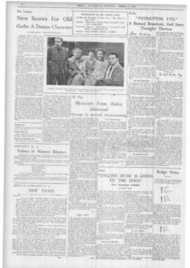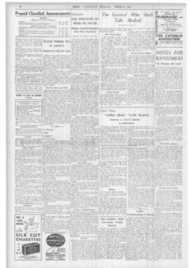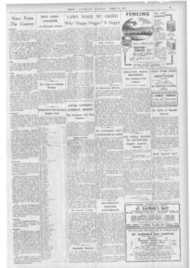Page 12, 12th March 1937
Page 12

Report an error
Noticed an error on this page?If you've noticed an error in this article please click here to report it.
Tags
Share
Related articles
The Educational Film
Problems Of Longer School Life
They Prefer
Family Life In Malta No Civil Marriage And No Divorce
The Private Cinema
Education
THE INFLUENCE OF FILMS ON YOUTH Modern Schools Equipped with Film Projectors
From Our Educational Correspondent One of the results of the public elementary school system may truly be said to be the production of a literate population. Consequent upon this has been the development of the public library system and the growth of circulation libraries. Books have been written and published to cater for all tastes and desires: books to satisfy those who desire to acquire knowledge, and others, for those who desire to while away their leisure hours. Whilst the majority have been written to satisfy these needs, others have had a more sinister purpose. This purpose has on occasion been of such a nature that it has been necessary to supply Catholic books and pamphlets to cornbat that influence.
A similar position has arisen from the growth of popularity of the cinema which necessitated the campaign in America to counteract the evil influence of certain types of film.
B.F.I. Report The question of the relationship between the cinematograph and school has been brought to the fore by the recent report of the Conference on Films for Children, published by the British Film Institute.
The number of film displays passed for adults only, and to which children are taken by their parents, has led the London Head Teachers' Association to collaborate with the industry in an endeavour to present programmes which will safeguard the children from the dangers of the "A" films and yet allow parents to indulge the desire of the child to attend the cinema. Arrangements have, therefore. been made for Saturday morning displays with a chain of over twenty large cinema proprietors.
Whilst the latter are keen to co-operate in this way, as business people they have to be shown that there will be a reasonable return for the money expended in hiring films. Having convinced them, it was necessary to find producers willing to make films which would have a sufficiently large market and show a profit for the money invested.
Three Classes of Films
The British Film Institute set about this task by arranging for the examination and classification of existing reels on this basis. As a result of this work recommendations have been made which will be helpful in the production of reels for schools.
The types of films may roughly be divided into three classes for the purpose of education. The largest class is " instructional," which illustrate complete sequences of events or actions.
Examples of this class are nature study films which depict the life of animal and bird. The films produced in conjunction with the Physical Training Organisers to the London County Council illustrating the Board of Education Syllabus of Physical Exercises shows the handling of classes and the response made thereto by classes of children from the elementary school.
Yet the film most likely to produce the greatest good and never become out-of-date is the Catholic film, The Holy Mass.
This film is photographed from the side and every movement of the priest is shown. When a priest acts as commentator whilst the film is shown the maximum value is derived from the display.
Woolwich's Lead
In the Borough of Woolwich the local Council arranges each year a programme of films to be displayed in the Town Hall three times a day on one day in each month. The programme contains a film of each class, "instructional," "expositional"—such as a portrayal of the heart and circulation of blood, and "vocational"—depicting the types of employment which go to make up a particular form of production, e.g., farming.
Classes from each of the local schools make these educational visits. Since the children vary in age and ability much of the value of the display may be lost. though this arrangement is in itself cheap and simple.
Expositional films shown in this way are almost valueless if no lesson is given either before or after viewing.
The most effective way to use films would be to have separate apparatus in each school. Thus the school should be able to requisition appropriate films arranged to correspond to the curriculum. Lessons could he given, the film displayed, then discussed by the class and the film shown again in order to fix ideas.
Cinema—A School Fixture
Plans of new schools now submitted to the Board of Education contain provision for a cinematograph operating room. If this development in education does lead to an increased cinema-going public it is essential to sec that only morally good films are shown in places where children form part of the audience and the British Film Institute be supported in their effort.
It is interesting to recall that the Catholic Herald was a pioneer in this matter, when a few years ago the proprietors successfully arranged for the display of films such as Aniakchak — films which captured the imagination and were entirely free from bad influences.
blog comments powered by Disqus

















